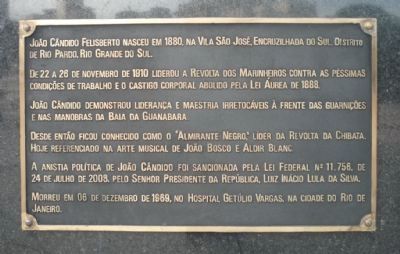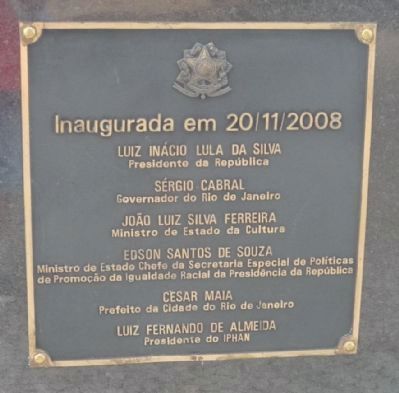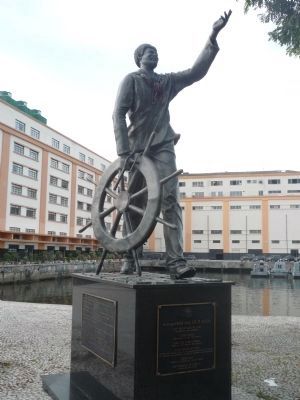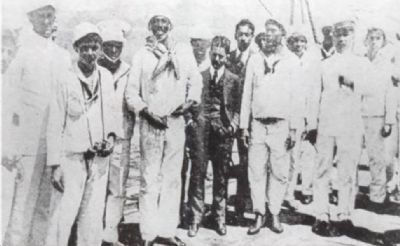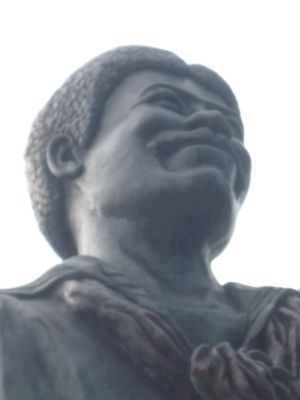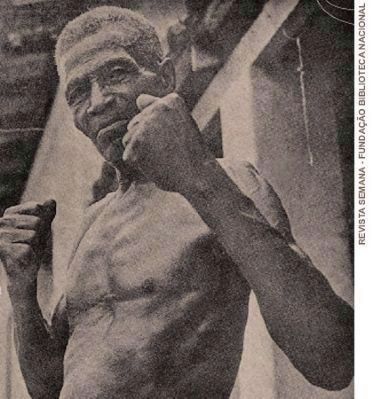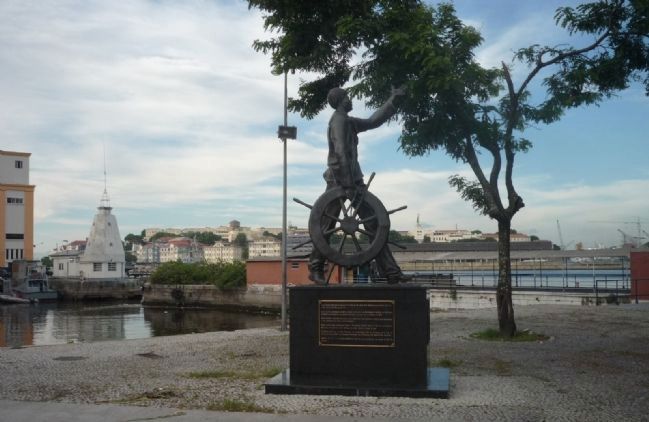Centro in Rio de Janeiro, Brazil — Southeast Region (Coastal)
João Cândido Felisberto Memorial
"O Almirante Negro"
Inscription.
[Panel 1]
João Cândido Felisberto nasceu em 1880, na Vila Sâo José, Encruzilhada do Sul, Distrito de Rio Pardo, Rio Grande do Sul.
De 22 a 26 de Novembro do 1910 liderou a Revolta Dos Marinheiros contra as péssimas condiçôes de trabalho e o castigo corporal abolido pela Lei Âurea de 1888.
João Cândido demonstrou liderança e maestria irretocâveis à frente das guarniçôes e nas manobras da Baia Da Guanabara.
Desde então ficou conhecido como o ‘Almirante Negro,’ líder da Revolta da Chibata. Hoje referenciado na arte musical de João Bosco e Aldir Blanc.
A anistia política de João Cândido foi sancionada pela Lei Federal No. 11.756, de julho de 2008, pelo Senhor Presidente da República, Luiz Inácio Lula da Silva.
Morreu em 06 de dezembro de 1969, no Hospital Getulio Vargas, na cidade do Rio de Janeiro.
[Panel 2]
Inaugurada em 20/11/2008
Luiz Inácio Lula da Silva, Presidente da República
Sérgio Cabral, Governador do Rio de Janeiro
João Luiz Silva Ferreira, Ministro de Estado da Cultura
Edson Santos De Souza, Ministro de Estado Chefe da Secretaria Especial de Políticas de Promoção da Igualdade Racial da Presidência da República
Cèsar Maia, Prefeito da Cidade do Rio de Janeiro
Luiz Fernando De Almeida, Presidente do IPHAN
Translated to English the marker reads:
João Candido Felisberto was born in 1880, in the town of Sâo José, Encuzilhada do Sul, District of Rio Prado, Rio Grande do Sul.
From November 22 to 26, 1910, he led the Sailors’ Revolt against their deplorable working conditions and the corporal punishment abolished by the Âurea Law of 1888.
João Candido showed leadership and flawless expertise at the front of the negotiations and in maneuvers on Guanabara Bay.
Ever since known as the “Black Admiral” and leader of the “Revolt of the Whip.” Today referenced in the art musical of João Bosco and Aldir Blanc.
The political amnesty of João Candido was sanctioned by Federal Law No. 11,756 of July 24, 2008, by the Honorable President of the Republic, Luiz Inácio Lula da Silva.
Died December 6, 1969, in the Getulio Vargas Hospital in the city of Rio de Janeiro.
[Panel 2]
Erected November 20, 2008
Luiz Inácio Lula da Silva, President of the Republic
Sérgio Cabral, Governor of Rio de Janeiro
João Luiz Silva Ferreira, Minister of State for Culture
Edson Santos De Souza, Minister of State, Chief of the Special Secretariat for the Promotion of Racial Equality of the Presidency
Cèsar Maia,
Mayor of the City of Rio de Janeiro
Luiz Fernando De Almeida, President of IPHAN
Erected 2008 by Republic of Brazil.
Topics. This historical marker and memorial is listed in these topic lists: Civil Rights • Waterways & Vessels. A significant historical year for this entry is 1880.
Location. 22° 54.125′ S, 43° 10.386′ W. Marker is in Rio de Janeiro. It is in Centro. Marker can be reached from Avenida Alfredo Agache. Marker is in the Praça Mercado Municipal. The memorial is separated from the Praça de 15 Novembre by Avenida Presidente Kubitschek and is adjacent to the waterfront at the north end of the Praça Mercado Municipal. Touch for map. Marker is at or near this postal address: Praça Quinze de Novembro 96, Rio de Janeiro 20010-010, Brazil. Touch for directions.
Other nearby markers. At least 8 other markers are within 10 kilometers of this marker, measured as the crow flies. Praça 15 de Novembro (about 120 meters away, measured in a direct line); Ordem Terceira do Carmo Church (approx. 0.3 kilometers away); Christ the Redeemer Monument (approx. 5 kilometers away); CCAPA (approx. 5.5 kilometers away); Cristovão Leite de Castro (approx. 5.5 kilometers away); Augusto Ferreira Ramos (approx. 5.5 kilometers away); APA das Pontas de Copacabana e Arpoador (approx. 9.5 kilometers away); Copacabana Fort (approx. 9.5 kilometers away). Touch for a list and map of all markers in Rio de Janeiro.
Also see . . .
1. João Cândido. (Submitted on December 31, 2009, by Richard E. Miller of Oxon Hill, Maryland.)
2. Wikipedia entry for Lei Âurea. (Submitted on December 31, 2009, by Richard E. Miller of Oxon Hill, Maryland.)
3. Naval Mutinies of the Twentieth Century: An International Perspective. The 1910 "Revolt of the Lash" is discussed in this book by C. Bell and Bruce A. Elleman, first published in 2003 by Frank Cass Publishers. While the marker references the "Golden Law," the abolition of slavery in Brazil (May 13, 1888), as the impetus behind the Sailors Revolt it is unclear as to the relation. Other references tie the revolt to protest against corporal punishment, which was supposedly abolished in the Brazilian Navy on 16 November 1889, but continued to be practiced, "in express opposition to the determination of Brazilian Law." (Submitted on January 4, 2010.)
Additional keywords. Afro-Brazilians "Revolt of the Lash" Minas Gerais Marinha do Brasil marinheiros pretos mutiny
Credits. This page was last revised on January 31, 2023. It was originally submitted on December 30, 2009, by Richard E. Miller of Oxon Hill, Maryland. This page has been viewed 3,236 times since then and 30 times this year. Photos: 1, 2, 3, 4, 5, 6, 7. submitted on December 31, 2009, by Richard E. Miller of Oxon Hill, Maryland. • Kevin W. was the editor who published this page.
